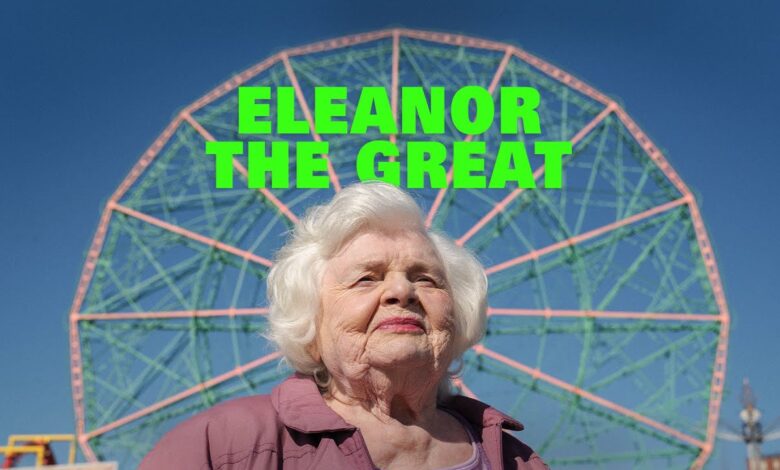Eleanor the Great Review: A Solemn Film on Solidarity and Human Connection

The cinematic world often gravitates toward stories that balance personal struggles with universal truths. Eleanor the Great, a film that has been quietly making waves on the indie circuit, is one such work. With its tender storytelling and understated visuals, the movie speaks to those seeking not only entertainment but also meaning, solace, and emotional resonance. At its core, Eleanor the Great is about solidarity—solemn, profound, and deeply human.
Introducing Eleanor the Great
When you first hear the title Eleanor the Great, you might expect a sweeping biopic, a historical epic, or even a tongue-in-cheek comedy. But director’s vision subverts all assumptions. Instead, this film is intimate and reflective, placing Eleanor—an ordinary woman in extraordinary circumstances—at the center of a quiet but powerful narrative.
Eleanor is not “great” in the traditional sense of heroics or fame. She does not conquer nations or command crowds. Rather, her greatness lies in her vulnerability, her capacity for compassion, and her unwavering search for connection. The film gently reminds us that greatness can exist in the small gestures we extend to one another, especially in moments of grief and isolation.
Story and Themes
At its heart, Eleanor the Great is a meditation on aging, loneliness, and the human need for solidarity. Eleanor is an older woman grappling with the passing of her closest friend, a loss that forces her to confront her own mortality and the shifting patterns of her social world. Instead of rushing to distract herself, Eleanor allows the silence and emptiness to teach her something profound.
The narrative does not rely on grand plot twists or heavy-handed dramatics. Instead, it unfolds like a carefully composed piece of music—soft notes, pauses, and crescendos that build toward an emotional release. Through Eleanor’s quiet resilience, the film reflects on what it means to age in a society that often sidelines the elderly. It asks viewers to consider: What happens when the pillars of our lives—the people, routines, and relationships—begin to fall away?
Themes of solidarity emerge strongly throughout the film. Eleanor does not seek pity or rescue. Instead, she longs for a kind of solemn togetherness, an acknowledgment that even in our solitude, we are part of something larger. This message resonates in today’s fast-paced, disconnected world.
Performance and Characterization
Much of the film’s power comes from the central performance. The actress embodying Eleanor delivers a nuanced portrayal that feels lived-in and authentic. Her every glance, pause, and subtle gesture carries weight. Rather than relying on dialogue-heavy scenes, she communicates through silence, body language, and expressive eyes. This restraint allows the audience to project their own emotions onto her journey.
Supporting characters, though less prominent, enrich the story’s texture. Neighbors, acquaintances, and strangers form a patchwork of fleeting interactions. Each encounter underscores the film’s central question: How do we show up for one another in times of quiet despair? The ensemble cast never overshadows Eleanor but instead illuminates different aspects of her search for meaning.
Cinematography and Atmosphere
Visually, Eleanor the Great is minimalist yet striking. The camera often lingers on still moments—a cup of tea left to cool, a chair sitting empty, a face framed by fading sunlight. These images mirror Eleanor’s emotional state and create space for viewers to breathe and reflect. The muted color palette enhances the somber mood, but occasional bursts of brightness hint at hope and renewal.
The director’s choice of pacing is deliberate. Long takes allow scenes to unfold organically, free from rushed editing. This patience draws the audience into Eleanor’s interior world, encouraging us to slow down and truly feel the weight of her solitude. The result is a meditative experience that blurs the line between film and lived memory.
Music and Sound Design
Sound plays an understated but vital role in Eleanor the Great. Instead of a constant musical score, the film embraces silence, broken only by natural sounds: footsteps on a wooden floor, birdsong outside a window, or the distant hum of traffic. When music does appear, it is sparse and delicate—piano notes or strings that underline Eleanor’s emotions without overpowering them. This restraint adds to the film’s solemn atmosphere, guiding viewers gently rather than directing their feelings forcefully.
The Message of Solidarity
The title’s emphasis on “the Great” becomes clearer as the film unfolds. Eleanor’s greatness is not in what she does but in how she endures, how she seeks and offers solidarity. The film argues that greatness can be found in the quiet dignity of showing up for others, even when words fail. Eleanor is great because she teaches us that empathy and presence matter more than accolades or achievements.
This theme is especially timely in our current era, marked by isolation, disconnection, and the aftershocks of a global pandemic. Eleanor the Great serves as both a mirror and a balm. It reflects the loneliness many people feel but also offers a reminder that solidarity—even solemn, understated solidarity—remains possible.
Audience Reception
Early reactions to Eleanor the Great highlight its emotional depth and meditative quality. Some viewers describe it as a healing experience, while others admit it left them in tears. Critics praise the film’s refusal to pander to commercial expectations, instead offering an authentic exploration of human fragility. However, the film’s slow pace may challenge those accustomed to faster, more plot-driven cinema. Yet, for those willing to surrender to its rhythm, the rewards are profound.
Why Eleanor the Great Matters
In an industry often dominated by spectacle, Eleanor the Great dares to be subtle. It prioritizes intimacy over intensity, contemplation over confrontation. This choice is radical in its own right, underscoring the importance of stories that honor everyday experiences. Eleanor’s journey encourages audiences to reflect on their own relationships, their own solitude, and their own definitions of greatness.
Films like Eleanor the Great remind us why cinema matters—not just as entertainment but as art that helps us process the human condition. It may not boast dazzling effects or explosive moments, but its quiet honesty leaves a lasting impact.
Final Thoughts
Ultimately, Eleanor the Great is not a film for everyone. Its solemn tone, unhurried pacing, and understated style demand patience and introspection. Yet for those seeking more than distraction, it offers something rare: a space to reflect, to grieve, and to feel connected. Eleanor is “great” not because she solves her problems or conquers her fears, but because she embodies the beauty of vulnerability and the strength of solidarity.
As the credits roll, viewers may find themselves sitting in silence, processing the experience long after the screen goes dark. That silence is not empty but full—full of echoes, memories, and a renewed awareness of the fragile threads that bind us together. In that sense, Eleanor the Great succeeds brilliantly. It is not just a film—it is a gentle call to solemn solidarity, and one worth answering.



